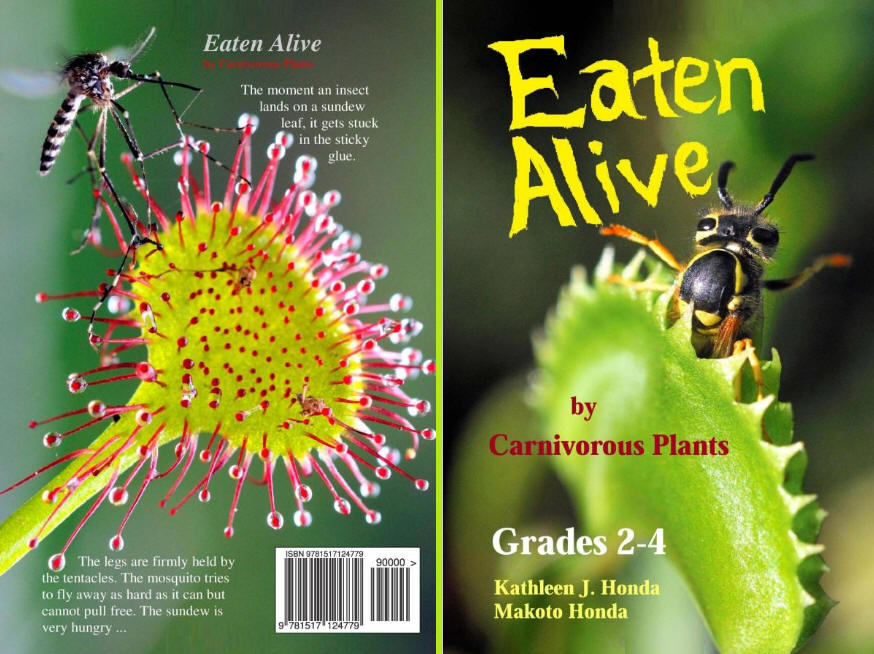HOME
Eaten Alive
by Carnivorous Plants
_______
Kathleen J. Honda & Makoto Honda
Copyright (c) 2015 by Kathleen J. Honda & Makoto Honda.
All Rights Reserved.
My email:
mhondax@gmail.com
"Carnivorous
Plants Juvenile Literature"
TO WRITE A BOOK REVIEW ON AMAZON.COM
__
This book is available in three editions: Color paperback, BW paperback, and Kindle edition.
Color Edition -
6 x 9 inch (48 pages)
List Price: $8.95 (Amazon price)
Contents shown below
Color
Edition - 7 x 10 (48 pages) - just a larger size List Price: $8.95 (Amazon
price)
See
7x10 contents
Black&White Photo Edition - 6 x 9 (48 pages) List Price: $7.99 (Amazon price)
Kindle Edition - color digital book
List Price: $1.99 (Amazon price)
__
This is a natural
science book for a young audience, ages 7-9 (grades 2-4), on the subject of
carnivorous plants. These are unique plants found in bogs and swamps. The soils
where they grow are very poor in nutrition. In order to survive in these hostile
environments, some plants have acquired an ability to catch and digest insects
and other small bugs. There are over 750 kinds of flowering plants that possess
this meat-eating habit. These plants are collectively known as carnivorous
plants because of their unique lifestyle. Carnivorous plants are found
worldwide. Some grow widely while some are restricted to a small area. For
instance, the Venus flytraps grow wild only in coastal North and South Carolina
in the United States. There are four major trap types used by carnivorous
plants: Snap-trap (Venus flytrap), pitfalls (pitcher plants/cobra plant),
flypaper traps (sundews/butterworts), and suction traps (bladderworts). You will
learn each of these trapping mechanisms as you read along. Just like normal
plants need to attract pollinators to their flowers, carnivorous plants need to
attract prey to their deadly traps. In order to achieve this, many carnivorous
plants disguise their traps with brilliant colors and sweet nectars, just like
real flowers do. Often, this trick is so effective that insects visit the trap
in the same manner they visit flowers - and are captured and eaten! Did you know
that you must touch Venus flytrap's trigger hairs, not once, but twice to close
the trap? Venus flytraps catch and eat only large, worthy bugs, and tiny bugs
are let go. How many times do you think you can trick a Venus flytrap's trap
with your finger before it stops responding? All these and more are described in
detail in the book. This is an informative natural science book filled with many
vivid images accompanying the text. This book takes you and your young audience
to the natural habitats of North America where many carnivorous plants grow
wild. This is a good reference book for a school science project. Enjoy!
Review
Eaten Alive by Carnivorous Plants by Kathleen J. Honda and
Makoto Honda is an educational book for kids from grades 2-4 that tells them
in detail about the existence of carnivorous plants. These plants are found
worldwide and they lead a unique lifestyle. The different ways of trapping
insects are explained in the book which also elaborates on the trapping
mechanism. The book takes you to North America where many of these
carnivorous plants grow wild. The written matter is supported by beautiful
color pictures that make it more interesting to young readers. There are
around 600 flowering plants that have meat eating habits.
It is an excellent book that is packed with information and can be kept in
libraries for reference and science projects. It is interesting not only for
kids, but also for adults. The pictures complement the book, making it
colorful and appealing to kids. I enjoyed reading about the four different
types of carnivorous plants. The descriptions are detailed and the pictures
are indicative of how an insect views the plant. The writing style is easy
for kids to understand. The book told me a lot about carnivorous plants. It
is quite interesting to learn that these plants can be grown at home. And it
is also amazing to learn how these plants with beautiful and delicate
flowers actually trap creatures and eat them. I thoroughly enjoyed reading
this. Very useful and informative.
Reviewed By Mamta Madhavan for Readers' Favorite
From the Author
We wrote this book to introduce a young audience to the
wonder of the natural world. Everybody assumes that plants are to be eaten
by animals. We only think of man-eating trees in the movies and cartoons.
But there are, indeed, plants in this world that catch and eat small animals
for nourishment. These meat-hungry plants are called "carnivorous plants."
One of the greatest naturalists of our times, Charles Darwin, published a
book "Insectivorous Plants" in 1875. The title means "insect-eating." In the
history of botany, Darwin was one of the first to demonstrate --- with
convincing evidence --- that some plants had been adapted to the carnivorous
habit. Since the diet of these plants are not restricted to "insects", but
also includes spiders and other small creatures, the term "carnivorous
plants" is more general and appropriate.
Click the
cover below to see the book page by page...

Eaten Alive by Carnivorous
Plants - Juvenile Literature (grades 2-4 / ages 7-9)
Copyright (c) 2014 by Kathleen J. Honda & Makoto Honda. All Rights Reserved.
Email: mhondax@gmail.com
__________________
For
the Venus flytrap, click here for
"Venus Flytrap for Kids
& Teachers"